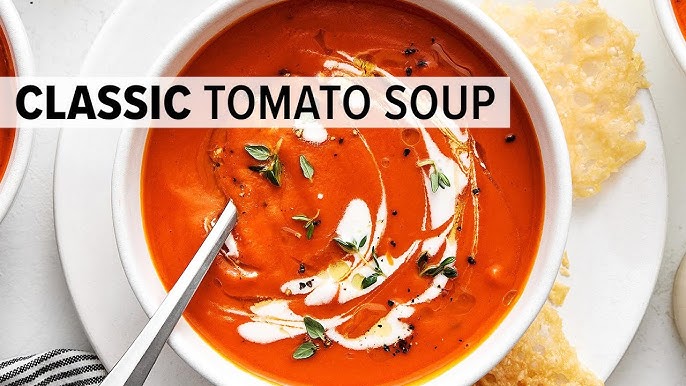Easy Tomato Soup Recipe: Who doesn’t love a warm bowl of tomato soup on a chilly day? It’s comforting, tangy, slightly sweet, and incredibly easy to make. Whether you’re looking for a quick weeknight dinner, a light lunch, or just something cozy to sip on while you binge-watch your favorite series, tomato soup never fails. But here’s the thing—most store-bought versions are either too salty, too bland, or packed with preservatives. So, what’s the solution? A simple, homemade tomato soup that tastes 10x better than anything from a can and doesn’t take hours to cook.
This recipe is especially great if you’re a beginner in the kitchen. You don’t need any fancy ingredients or special chef skills—just a few pantry staples, some fresh or canned tomatoes, and a willingness to enjoy something truly satisfying. In the next few sections, I’ll walk you through everything you need to know to make this classic dish, step by step.
So grab your apron and let’s dive into the world of homemade tomato soup.
Ingredients You’ll Need
One of the best things about tomato soup is its simplicity. You likely have most of the ingredients in your kitchen already. And guess what? There’s room for creativity if you want to spice things up a bit.
Here’s what you’ll need:
- Tomatoes (6–8 medium fresh or 1 large can of whole peeled tomatoes)
- Onion (1 medium, chopped)
- Garlic (2–3 cloves, minced)
- Olive oil or butter (2 tablespoons)
- Vegetable broth or chicken stock (2 cups)
- Salt (to taste)
- Black pepper (freshly ground, to taste)
- Sugar (1 teaspoon, optional to balance acidity)
- Basil or oregano (1 teaspoon dried or a handful of fresh leaves)
- Cream or milk (optional, for richness)
Fresh vs. Canned Tomatoes
Both work great, but if tomatoes are in season, fresh ones offer unbeatable flavor. Go for ripe, juicy tomatoes like Roma or plum varieties. If you’re using canned, choose high-quality whole peeled tomatoes for best results.
This combination of simple ingredients delivers deep, savory flavor with a touch of sweetness. And the best part? You can customize it to suit your preferences.
Kitchen Tools Required
You don’t need a gourmet kitchen to pull off this soup. Just a few basic tools will do the trick:
Here’s your toolkit:
- Large pot or Dutch oven
- Wooden spoon or spatula
- Blender or immersion blender
- Knife and cutting board
- Measuring cups and spoons
- Soup ladle
That’s it. No stand mixer. No food processor. Just your everyday kitchen basics. A good pot makes all the difference—it helps build flavor as everything cooks evenly. If you have a stick (immersion) blender, it’s super convenient for blending the soup right in the pot, but a standard blender works fine too—just be careful with the hot liquid!
Step-by-Step Tomato Soup Recipe
Alright, now for the heart of the recipe. This section walks you through everything from prepping the tomatoes to adding that final swirl of cream. Let’s break it down.
Step 1 – Preparing the Tomatoes
If you’re using fresh tomatoes, this step is crucial for achieving that smooth, rich flavor you expect from good tomato soup.
How to Prep Fresh Tomatoes:
- Wash and score: Wash your tomatoes and use a knife to cut a small “X” at the bottom of each one.
- Blanch: Drop them into boiling water for about 30–60 seconds, or until you see the skins starting to peel.
- Shock: Immediately transfer them to a bowl of ice water. This makes peeling super easy.
- Peel and chop: Once cooled, peel off the skin and roughly chop the tomatoes.
Why blanch and peel? Because the skin can make your soup gritty. This extra step makes all the difference for that smooth texture.
Using canned tomatoes? Skip the peeling. Just pour the can (juice and all) right into your pot when the time comes. Easy peasy.
Step 2 – Sautéing the Base
This is where flavor-building begins. Think of it as laying down the foundation of a really good soup.
What You’ll Do:
- Heat the olive oil or butter in a large pot over medium heat.
- Add chopped onions and cook until they’re soft and slightly golden—about 5–7 minutes.
- Toss in the garlic and sauté for another minute until fragrant.
This step isn’t just about softening the veggies—it’s where you start building that savory, slightly sweet flavor profile. Don’t rush it. Let the onions caramelize just a bit for deeper flavor.
Once everything is softened and smelling amazing, you’re ready to move on to the star of the show: the tomatoes.
Step 3 – Adding Tomatoes and Seasonings
Now that your base is ready, it’s time to layer in the flavor. The tomatoes are the heart of this dish, and how you season them will define the final taste of your soup.
Here’s how to do it:
- Add the tomatoes (whether fresh or canned) to your sautéed onion and garlic base.
- Pour in the broth or stock. You can use vegetable broth for a vegetarian version or chicken stock for a bit more richness.
- Season generously with salt and pepper.
- Add your herbs—dried oregano, thyme, or basil all work beautifully. If you’re using fresh herbs, add them closer to the end of cooking.
At this stage, you can also throw in a pinch of sugar if your tomatoes taste too acidic. It’s a small addition that makes a huge difference in balancing the flavors.
Bring everything to a gentle simmer and let it cook uncovered for 20–25 minutes. This allows the flavors to blend, the tomatoes to break down, and the broth to reduce slightly for a more concentrated taste. Stir occasionally to prevent sticking.
Step 4 – Blending the Soup
This step is all about transforming that chunky mixture into a creamy, velvety soup. Blending is where the magic happens!
Options for Blending:
- Immersion Blender: Stick it right into the pot and blend until smooth. Super convenient, less cleanup.
- Traditional Blender: Let the soup cool slightly, then blend in batches. Be sure to remove the center cap of the lid and cover with a towel to release steam safely.
Blend until the soup reaches your desired consistency. Some people like it completely smooth, while others prefer a bit of texture. You do you.
If it seems too thick, just add a little more broth or water to thin it out. Too thin? Let it simmer a bit longer after blending.
Step 5 – Final Touches
Here’s where you take your soup from “really good” to “OMG, this is amazing.”
Make it creamy:
- Add cream or milk (just a splash) for richness.
- Coconut milk if you’re going vegan—it adds a hint of sweetness and depth.
- Butter swirl for glossy finish and flavor bump.
Stir well, let it simmer for another 5 minutes, and do a final taste test. Need more salt? More herbs? A touch of heat from chili flakes? Now’s the time to tweak.
And just like that—your homemade tomato soup is ready to serve.
Serving Suggestions
Tomato soup is one of those dishes that’s always better with a sidekick. Sure, it’s delicious on its own, but pair it with the right companion, and it becomes an unbeatable meal.
Here are some tasty ideas:
- Grilled Cheese Sandwich: The classic pairing. Dip and enjoy!
- Garlic Bread or Baguette: Crunchy, buttery, perfect for soaking up the soup.
- Croutons: Homemade or store-bought, they add a nice texture contrast.
- Cheese Toast: Top a slice of bread with cheese, broil it, and float it on the soup.
Want to get fancy? Try garnishing with:
- A swirl of cream or coconut milk
- Fresh basil leaves
- A drizzle of chili oil
- Toasted seeds or nuts for crunch
Whether you’re serving it as an appetizer or a main course, this soup is all about cozy vibes and bold flavor.
Tomato Soup Variations
Feeling adventurous? Tomato soup is incredibly versatile. With a few tweaks, you can create versions from around the globe.
Here are a few ideas to try:
1. Roasted Tomato Soup
- Roast halved tomatoes, onions, and garlic in the oven before blending.
- Adds depth, smokiness, and a hint of sweetness.
2. Spicy Indian Tomato Soup
- Add cumin seeds, ginger, and garam masala.
- Finish with a splash of coconut milk or a spoon of yogurt.
3. Tomato Basil Soup
- Add a big handful of fresh basil during blending.
- Classic and aromatic.
4. Creamy Tomato Soup
- Use heavy cream, cream cheese, or even Greek yogurt for ultra-smooth texture.
5. Chunky Garden Tomato Soup
- Skip the full blend and leave some tomato and veggie bits for a rustic feel.
Feel free to experiment and make it your own. That’s the beauty of this soup—it’s a blank canvas for flavor.
Storage and Reheating Tips
One of the best things about homemade tomato soup is how well it stores. Make a big batch on Sunday, and you’ve got comfort food ready to go all week long.
How to Store Tomato Soup:
- In the Fridge: Let the soup cool completely, then transfer it to an airtight container. It’ll stay fresh for up to 5 days in the refrigerator.
- In the Freezer: Pour the cooled soup into freezer-safe bags or containers (leave some space at the top for expansion). It freezes beautifully and can be stored for up to 3 months.
Reheating Tips:
- Stovetop: Pour the soup into a pot and warm over medium-low heat, stirring occasionally until heated through.
- Microwave: Transfer to a microwave-safe bowl, cover loosely, and heat in 30-second intervals, stirring in between.
Pro tip: If you’ve added cream or milk, stir frequently while reheating to prevent curdling. And always taste after reheating—you might need to re-season it just a bit.
Health Benefits of Tomato Soup
Tomato soup doesn’t just taste good—it’s also a nutritional powerhouse, especially when made from scratch.
Here’s why you should feel good about that second bowl:
- Rich in antioxidants: Tomatoes are loaded with lycopene, which is known to reduce inflammation and protect against certain cancers.
- Low in calories: Especially if you skip the cream, this soup can be a low-calorie, nutrient-dense meal.
- Good for the heart: Lycopene also supports heart health by lowering bad cholesterol levels and blood pressure.
- Boosts immunity: Garlic and onions are rich in compounds that help strengthen the immune system.
- Hydrating and light: With a high water content, tomato soup is great for hydration without being heavy.
Add in some fresh herbs and olive oil, and you’ve got a bowl full of flavor and health benefits. Who knew comfort food could be this good for you?
Common Mistakes to Avoid
Even with a simple recipe like tomato soup, a few easy-to-make mistakes can affect your final result. Let’s break down some of the most common ones and how to avoid them.
1. Using Under-Ripe or Tasteless Tomatoes
- If your fresh tomatoes aren’t juicy and flavorful, your soup won’t be either.
- Use ripe, in-season tomatoes or high-quality canned ones for best results.
2. Skipping the Sauté
- Don’t rush the onions and garlic step. It builds the flavor base.
- Caramelizing them a little adds natural sweetness.
3. Not Seasoning Properly
- Salt brings out the natural flavors of the tomatoes.
- Don’t forget a bit of sugar if your soup tastes too acidic.
4. Overcooking the Soup
- Long boiling times can dull the bright tomato flavor.
- A gentle simmer is all you need.
5. Blending Carelessly
- Hot soup can be dangerous to blend in a standard blender.
- Always let it cool slightly and vent the lid.
Avoid these mistakes, and your tomato soup will come out rich, flavorful, and just the right balance of smooth and hearty.
FAQs about Easy Tomato Soup Recipe
Q1: Can I use fresh tomatoes instead of canned?
Absolutely! Fresh tomatoes work great—just blanch, peel, and blend them. Roma or plum tomatoes are best for a rich flavor.
Q2: How can I make my tomato soup creamy?
To make it creamy, stir in heavy cream or coconut milk at the end. For a dairy-free version, use cashew cream or blended silken tofu.
Q3: Can I freeze homemade tomato soup?
Yes, tomato soup freezes well. Let it cool completely, pour it into airtight containers or freezer bags, and store for up to 3 months.
Q4: What herbs go best with tomato soup?
Basil, thyme, oregano, and bay leaves are classic choices. Fresh herbs give a burst of flavor, while dried ones work well too.
Q5: How do I thicken tomato soup?
Simmer the soup longer to reduce liquid, or add a tablespoon of tomato paste or a mashed potato for natural thickness.
Q6: Is tomato soup healthy?
Yes! Tomato soup is low in calories and packed with antioxidants like lycopene. Skip the cream for an even lighter option.
Q7: What can I serve with tomato soup?
Grilled cheese is a classic pairing. You can also try garlic bread, croutons, or a fresh green salad on the side.
Q8: Can I make this soup vegan or gluten-free?
Definitely. Use vegetable broth and plant-based cream for vegan. It’s naturally gluten-free, just double-check any store-bought ingredients.
Q9: How long does homemade tomato soup last in the fridge?
Stored in an airtight container, it will keep for 4–5 days. Reheat on the stove or microwave before serving.
Q10: Can I add other vegetables to the soup?
Yes! Carrots, bell peppers, or celery blend in nicely and add extra nutrition and flavor. Sauté them with the onions for best results.
Conclusion
And there you have it—your go-to, foolproof, step-by-step guide to making delicious, homemade tomato soup. Whether you’re a cooking newbie or just looking for something cozy and comforting, this recipe checks all the boxes. It’s easy, affordable, adaptable, and oh-so-satisfying.
Remember, cooking is meant to be fun, not stressful. So don’t be afraid to tweak the recipe to suit your taste. Add some chili for heat, a swirl of cream for richness, or a few croutons for crunch. Whatever makes your perfect bowl—go for it.
Now all that’s left is to grab a spoon, dip some grilled cheese, and enjoy the warm, cozy hug that only tomato soup can give.



